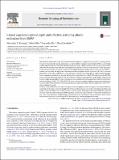L-band vegetation optical depth and effective scattering albedo estimation from SMAP
Author(s)
Das, Narendra; Konings, Alexandra G; Piles Guillem, Maria; Entekhabi, Dara
Download1-s2.0-S0034425717302961-main.pdf (2.078Mb)
PUBLISHER_CC
Publisher with Creative Commons License
Creative Commons Attribution
Terms of use
Metadata
Show full item recordAbstract
Over land the vegetation canopy affects the microwave brightness temperature by emission, scattering and attenuation of surface soil emission. Attenuation, as represented by vegetation optical depth (VOD), is a potentially useful ecological indicator. The NASA Soil Moisture Active Passive (SMAP) mission carries significant potential for VOD estimates because of its radio frequency interference mitigation efforts and because the L-band signal penetrates deeper into the vegetation canopy than the higher frequency bands used for many previous VOD retrievals. In this study, we apply the multi-temporal dual-channel retrieval algorithm (MT-DCA) to derive global VOD, soil moisture, and effective scattering albedo estimates from SMAP Backus-Gilbert enhanced brightness temperatures posted on a 9 km grid and with three day revisit time. SMAP VOD values from the MT-DCA follow expected global distributions and are shown to be highly correlated with canopy height. They are also broadly similar in magnitude (though not always in seasonal amplitude) to European Space Agency Soil Moisture and Ocean Salinity (SMOS) VOD. The SMOS VOD values are based on angular brightness temperature information while the SMAP measurements are at a constant incidence angle, requiring an alternate approach to VOD retrieval presented in this study. Globally, albedo values tend to be high over regions with heterogeneous land cover types. The estimated effective scattering albedo values are generally higher than those used in previous soil moisture estimation algorithms and linked to biome classifications. MT-DCA retrievals of soil moisture show only small random differences with soil moisture retrievals from the Baseline SMAP algorithm, which uses a prior estimate of VOD based on land cover and optical data. However, significant biases exist between the two datasets. The soil moisture biases follow the pattern of differences between the MT-DCA retrieved and Baseline-assigned VOD values.
Date issued
2017-07Department
Massachusetts Institute of Technology. Department of Civil and Environmental Engineering; Massachusetts Institute of Technology. Department of Earth, Atmospheric, and Planetary SciencesJournal
Remote Sensing of Environment
Publisher
Elsevier BV
Citation
Konings, Alexandra G., Maria Piles, Narendra Das, and Dara Entekhabi. “L-Band Vegetation Optical Depth and Effective Scattering Albedo Estimation from SMAP.” Remote Sensing of Environment 198 (September 2017): 460–470.
Version: Final published version
ISSN
00344257